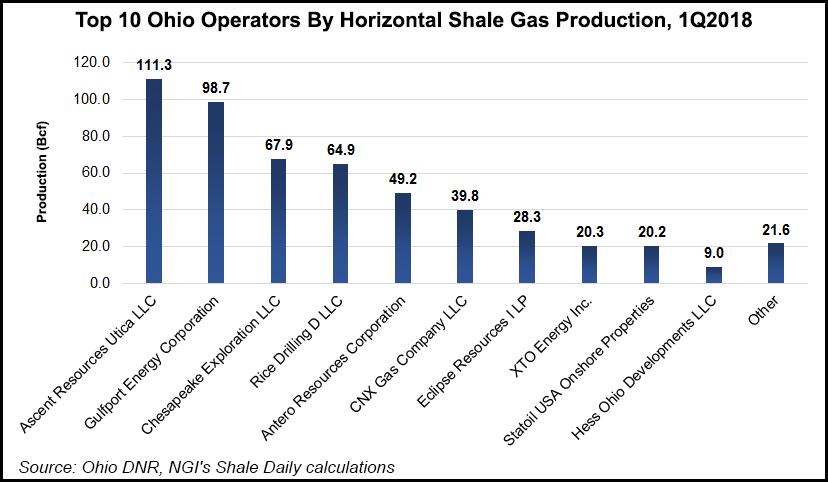Utica Shale | E&P | NGI All News Access | NGI The Weekly Gas Market Report
Utica Shale Natural Gas Production Hit New Record in First Quarter
Ohio’s unconventional natural gas production continued its upward climb in the first quarter, jumping more than 40% year/year (y/y) and setting a new state record at 531.3 Bcf.

That’s up from 371.9 Bcf in 1Q2017 and an increase from the previous record of 503 Bcf in 4Q2017, according to data released Wednesday by the Ohio Department of Natural Resources (ODNR).
Oil production meanwhile continued to seesaw. It declined by about 4% y/y, dropping to 3.9 million bbl in the first quarter. Oil production has fluctuated over the last several quarters, reflecting a broad shift to dry gas production that occured about two years ago across much of the Appalachian Basin when oil prices remained low.
While oil volumes slowly crept back up from lows for sequential increases last year, for example, they fell from roughly 18 million bbl in 2016 to 16.4 million bbl in 2017. First quarter oil production was also down slightly from 4Q2017, when unconventional producers reported 4.2 million bbl.
Ohio law does not require separate reporting of natural gas liquids (NGL) or condensate. Those totals are included in natural gas volumes. Some Appalachian operators in the region have, however, reported more NGL development since late last year as prices have improved.
ODNR’s first quarter report listed 1,949 horizontal shale wells, 1,909 of which reported oil and gas production during the period. The data consists almost entirely of Utica Shale production.
The average amount of oil produced by each well was 2,066 barrels, while the average amount of natural gas produced was 278.5 MMcf over 86 average days in production.
To date, the state has issued 2,843 horizontal Utica permits and 2,371 of those have been drilled. That’s up compared to the 2,518 permits issued at roughly the same time last year and the 2,014 that were drilled at that time.
© 2024 Natural Gas Intelligence. All rights reserved.
ISSN © 2577-9877 | ISSN © 1532-1266 | ISSN © 2158-8023 |
